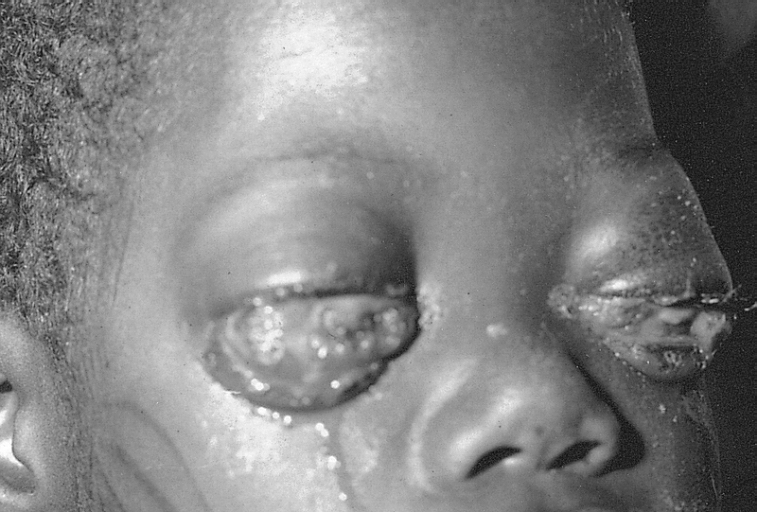Burkitt's lymphoma
For the WikiDoc page for this topic, click here
| Burkitt's lymphoma | |
 | |
|---|---|
| Burkitt lymphoma, touch prep, Wright stain | |
| ICD-10 | C83.7 |
| ICD-9 | 200.2 |
| ICD-O: | 9687/3 |
| OMIM | 113970 |
| DiseasesDB | 1784 |
| eMedicine | med/256 |
| MeSH | D002051 |
Template:Search infobox Editor-In-Chief: C. Michael Gibson, M.S., M.D. [1]
Please Take Over This Page and Apply to be Editor-In-Chief for this topic: There can be one or more than one Editor-In-Chief. You may also apply to be an Associate Editor-In-Chief of one of the subtopics below. Please mail us [2] to indicate your interest in serving either as an Editor-In-Chief of the entire topic or as an Associate Editor-In-Chief for a subtopic. Please be sure to attach your CV and or biographical sketch.
Overview
Burkitt's lymphoma (or "Burkitt's tumor", or "Malignant lymphoma, Burkitt's type") is a cancer of the lymphatic system (in particular, B lymphocytes). It is associated with the Epstein-Barr virus, also the cause of mononucleosis as well as other cancers. It is named after Denis Parsons Burkitt, a surgeon who first described the disease in 1956 while working in equatorial Africa.
Children affected with the disease often also had chronic malaria which is believed to have reduced resistance to the Epstein-Barr virus and allowed it to take hold. This is known as classical African or endemic Burkitt's lymphoma. Disease characteristics include large tumors in the facial or abdominal regions.
The sporadic type of Burkitt's lymphoma (also known as "non-African") is another form of non-Hodgkin lymphoma found outside of Africa in which cancer cells have a similar appearance to the cancer cells of classical African or endemic Burkitt's lymphoma. Again it is believed that impaired immunity provides an opening for development of the Epstein-Barr virus. Examination of chromosomes from these tumor cells often shows translocation of the myc and Ig genes (t: 8;14).
Microscopy
Consists of undifferentiated, small, noncleaved cells in broad sheets of tumor cells. Burkitt's lymphoma demonstrates starry sky appearance due to the macrophage ingestion of tumor cells.
Malignant B cell characteristics
Malignant B cells have identical DNA recombinations of the V(D)J region of the Immunoglobin genes. This means that no increase in specificity of Antibody molecules is occurring in the malignant cells. These malignant cells are thus clonal populations and can be assayed for by using DNA probes specific for the regions where recombination is expected. Normal DNA will be characterized by two high concentration of identical germ line DNA V(D)J regions and endless, likely undetectable, non-germline Ig V(D)J DNA. Lymphoma cells have an additional high concentration of V(D)J DNA that is unlike the germline, indicating clonal populations of B Cells that are not undifferentiated B Cells (Germline DNA cells). Assays typically use the process of Electrophoresis and southern blot analysis to determine the existence of these characteristics.
Classification
Currently Burkitt's lymphoma can be divided into three main clinical variants: the endemic, the sporadic and the immunodeficiency-associated variants.
- The endemic variant occurs in equatorial Africa. It is the most common malignancy of children in this area. Children affected with the disease often also had chronic malaria which is believed to have reduced resistance to the Epstein-Barr virus and allowed it to take hold. Disease characteristically involves the jaw or other facial bone, distal ileum, cecum, ovaries, kidney or the breast.
- The sporadic type of Burkitt lymphoma (also known as "non-African") is another form of non-Hodgkin lymphoma found outside of Africa. The tumor cells have a similar appearance to the cancer cells of classical African or endemic Burkitt lymphoma. Again it is believed that impaired immunity provides an opening for development of the Epstein-Barr virus. Non-Hodgkins, which includes Burkitt's, accounts for 30-50% of childhood lymphoma. Jaw is less commonly involved, comparing with the endemic variant. Ileo-cecal region is the common site of involvement.
- Immunodeficiency-associated Burkitt lymphoma is usually associated with HIV infection or occurs in the setting of post-transplant patients who are taking immunosuppressive drugs. Actually, Burkitt lymphoma can be the initial manifestation of AIDS.
By morphology (i.e. microscopic appearance) or immunophenotype, it is almost impossible to differentiate these three clinical variants. Immunodeficiency-associated Burkitt lymphoma may demonstrate more plasmacytic appearance or more pleomorphism, but these features are not specific.
Treatment
Effect of the chemotherapy, as with all cancers, depends on the time of diagnosis. With faster growing cancers, such as this one, the cancer actually responds faster than with slower growing cancers.
Other treatments are immunotherapy, bone marrow transplants, surgery to remove the tumor, and radiotherapy.
Pathological Findings
External links
Template:Chromosomal abnormalities
